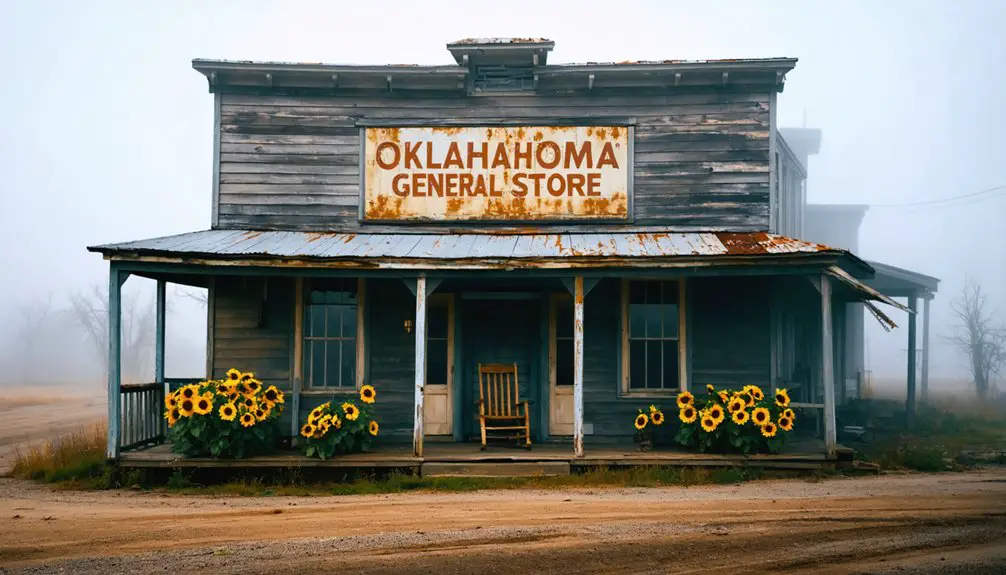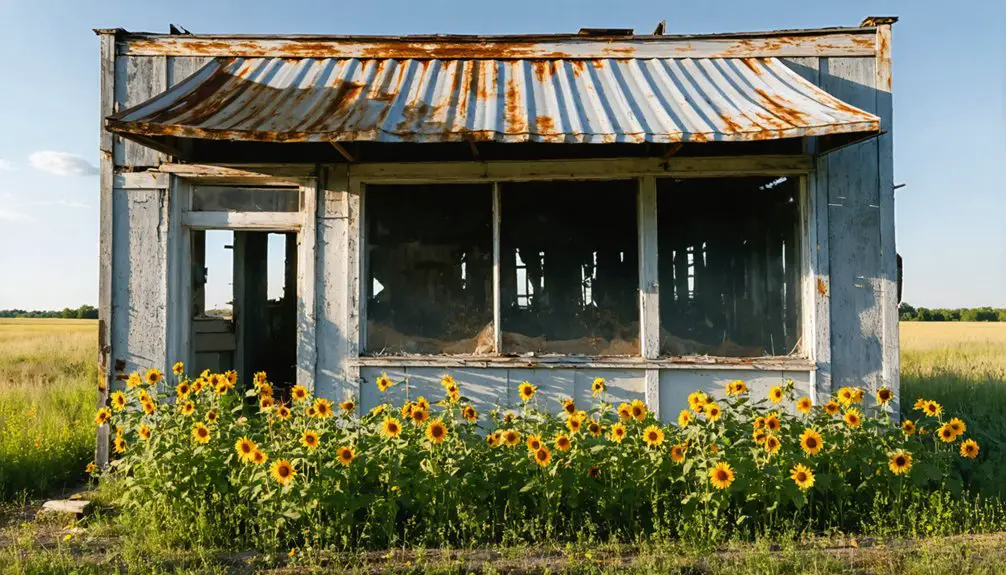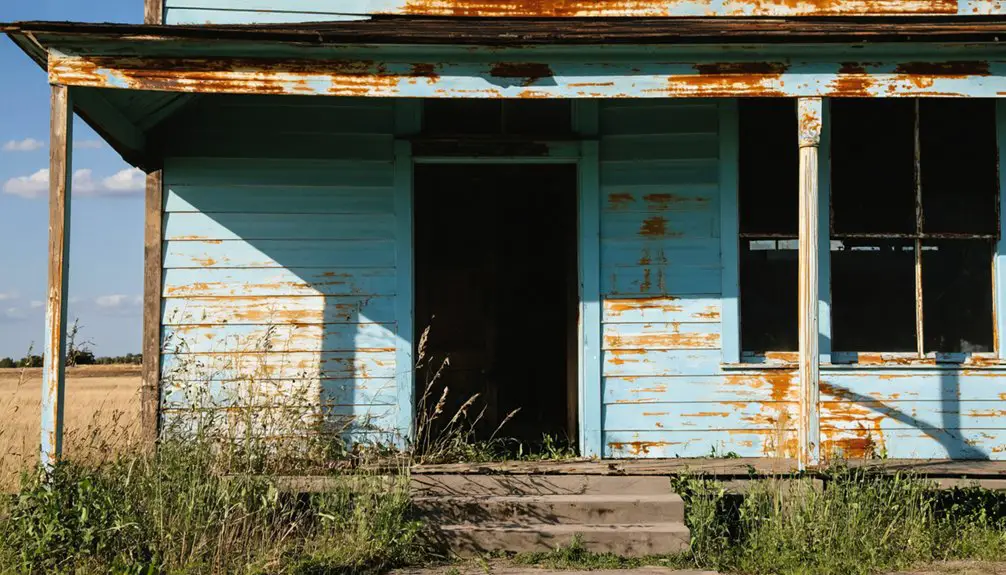You’ll find Bell, Oklahoma at a historic railroad junction that boomed in 1890 when the Bell family established farms and mines. The town thrived through mining operations, producing over $20 billion in lead and zinc ore during its peak years (1917-1947). Today, its population has dwindled from 602 in 2000 to just 390 in 2020, leaving behind contaminated lands, abandoned mines, and rich folklore tied to the Bell Witch legend. The town’s haunting past holds countless untold stories.
Key Takeaways
- Bell originated as a railroad junction town that thrived during Oklahoma’s mining boom but declined with the fall of rail transportation.
- The population dropped dramatically from 602 in 2000 to 390 in 2020, with projections showing continued decline to 295 by 2025.
- Mining operations, particularly the Big Soldier Mine, left lasting environmental damage including soil contamination and acid mine drainage.
- The town’s Native American identity remains strong, with over 96% of residents identifying as Native American.
- Local folklore includes ghost stories influenced by the Bell Witch legend and tales of hidden outlaw treasures.
Origins and Settlement History
While the Oklahoma Panhandle remained a lawless “No Man’s Land” until 1890, the Bell family‘s westward migration from Tennessee to the Red River area marked the beginning of Bell, Oklahoma’s settlement history.
You’ll find that pioneering families like the Bells were drawn to the untamed frontier’s promise of ranching and farming opportunities in these undeveloped lands.
The region’s settlement patterns shifted dramatically after the Organic Act of 1890, which finally incorporated the Panhandle into Oklahoma Territory.
Before this change, you’d have encountered a remote, isolated landscape where early settlers faced the challenges of limited governance and sparse population, similar to the conditions that led to the establishment of Boggy Depot by Chickasaw settlers.
The Bell family, led by patriarch John Bell, became central figures in the area’s development, establishing farms that formed the foundation of what would become the Bell community.
Much like their Tennessee roots where John Bell was a successful farmer, the family applied their agricultural expertise to tame the wild Oklahoma landscape.
Early Economic Development
The lack of formal governance turned Bell into a magnet for entrepreneurs seeking to profit from the legal vacuum.
As one of the primary economic drivers, alcohol sales thrived due to prohibition laws in neighboring Kansas and Texas. You’d find the town’s economy running almost entirely on entertainment and vice, with businesses operating free from taxation or regulation. The strategic positioning in No Man’s Land made it especially attractive for those looking to escape legal constraints. Like the lead and zinc mining that would later drive Picher’s economy, Bell’s informal economy attracted workers seeking opportunity.
The informal governance attracted a steady stream of visitors seeking refuge from stricter laws, though this dependency on transient populations ultimately contributed to the town’s short-lived success.
Railroad and Transportation Impact
Since railroads determined the fates of countless frontier towns, Bell’s story began at a crucial railroad intersection originally known as Bailey Junction. The railroad influence shaped not just the town’s location, but its very identity, as naming disputes erupted between local interests vying for control of this strategic point.
The first rail line through the area, the Texas & Pacific, arrived in 1873, marking the beginning of the region’s transformation. Similar to nearby ghost town Salt Fork, the rail lines served as economic lifelines, attracting merchants and enabling agricultural shipping to larger markets.
However, the region’s rapid railroad overbuilding between 1897-1907 proved unsustainable. By mid-20th century, as rail services declined and highway travel gained prominence, Bell began its shift toward ghost town status, leaving behind only remnants of its railroad-dependent past.
Mining and Resource Extraction
Mining activity in Bell emerged through two distinct operations that shaped the town’s economic landscape during the late 19th and early 20th centuries.
The Bell, Lewis and Yates Mining Co. established the Big Soldier Mine in 1890, implementing advanced mining techniques with beehive coke ovens and crushing facilities for coal processing. Their resource management approach included building company stores and community infrastructure to support workers. Like other mining operations of the era, workers were paid through a piecework system, earning around $2 per oven.
Bell, Lewis and Yates Mining Co. revolutionized local coal mining through modern facilities while fostering worker communities around the Big Soldier Mine.
Meanwhile, gold fever struck the Wichita Mountains near Bell in the early 1900s. You’ll find evidence of hundreds of mine shafts from this era, along with the ambitious but ill-fated Gold Belle Mill. EA Williams established the Gold Bell Mine in 1904, bringing new mining aspirations to the region.
Despite newspaper claims of rich discoveries and thousands of prospectors flooding the area, the U.S. Army had to restrict unauthorized mining before Oklahoma’s formal opening. Gold mining ultimately proved unprofitable.
Environmental Legacy and Challenges
The toxic legacy of mining operations in Bell left behind extensive soil and water contamination that you’ll find concentrated in chat piles containing lead, zinc, and other hazardous metals.
You can trace the water quality deterioration to 1967 when mine pumping ceased, allowing nearly 77,000 acre-feet of metal-contaminated groundwater to accumulate in abandoned shafts.
Testing revealed that 34% of children suffered from lead poisoning in the area by 1994.
The area produced over $20 billion worth of lead and zinc ore during its peak mining years between 1917 and 1947.
Mining Contamination Effects
During Bell’s operational mining years, the extraction of gold, silver, lead, copper, and zinc left behind devastating environmental impacts that continue to plague the region today.
You’ll find massive “chat” piles of toxic tailings scattered across the landscape, releasing dangerous heavy metals and cyanide compounds into the soil. These pollutants create severe health consequences for nearby residents, especially affecting children and pregnant women through dust inhalation and contaminated water exposure.
The ecological impact is equally concerning – acid mine drainage from flooded shafts has poisoned local waterways, while toxic metals accumulate in food chains.
You’re witnessing a perfect storm of environmental degradation, where contaminated soils, compromised water supplies, and persistent heavy metal pollution have transformed Bell into an abandoned monument to mining’s lasting wounds.
Local Water Quality Impact
Since mining operations ceased pumping in 1967, approximately 76,800 acre-feet of acidic water has flooded Bell’s abandoned mines, creating a devastating water quality crisis.
You’ll find the impact of this contamination extends far beyond the immediate area, as toxic metals have seeped into Tar Creek and the broader watershed. Water safety concerns have intensified since 1973, when contaminated mine water began visibly affecting local waterways with a distinctive reddish color.
- Heavy metals including lead, zinc, and cadmium have infiltrated groundwater systems.
- Contamination monitoring shows pollution spreading to the Neosho River and Grand Lake Reservoir.
- Local aquatic life exhibits dangerous levels of toxic metal bioaccumulation.
- Ongoing acid mine drainage continues to threaten regional water resources and ecosystem health.
Population Changes Over Time
Over the past two decades, Bell, Oklahoma has experienced dramatic population losses that threaten its status as a viable community.
You’ll find the starkest evidence of this decline in the numbers: from 602 residents in 2000, the population dropped to 535 by 2010, marking an 11.1% decrease.
The demographic shifts accelerated between 2010 and 2020, with population migration reducing the count to just 390 residents – a sharp 27% decline.
Bell’s dramatic exodus continued into the 2010s as its population plummeted by 27%, leaving just 390 residents remaining.
The town’s trajectory continues downward, with projections showing only 295 residents by 2025, reflecting an annual decline rate of 5.14%.
While the community maintains its strong Native American identity at 96.11% of residents, these persistent losses align with patterns seen in other Oklahoma towns that have ultimately reached ghost town status.
Local Folklore and Stories

While Bell, Oklahoma has its own unique ghost stories, the town’s folklore draws inspiration from the famous Bell Witch legend that originated in Tennessee during the early 1800s.
You’ll find similar supernatural elements woven into Bell’s spectral legends, though they’re distinctly shaped by local outlaw history and frontier justice.
- Ghostly encounters often feature unexplained noises, including wall-banging and mysterious footsteps around abandoned buildings.
- Tales of hidden outlaw treasures guarded by protective spirits, particularly linked to Belle Starr’s criminal activities.
- Reports of physical disturbances, like objects moving on their own and blankets being pulled off beds.
- Stories of supernatural retribution tied to violent events, shootouts, and wrongful imprisonments that occurred during the town’s frontier days.
Remaining Structures and Landmarks
The remnants of Bell, Oklahoma paint a haunting portrait of its mining town past through scattered residential and commercial ruins.
You’ll find abandoned homes with collapsed roofs and weathered walls, still containing traces of former residents’ belongings. Along the main street, decaying storefronts stand as hollow shells, with only rusted signage hinting at their former purpose.
Massive chat piles from lead and zinc mining operations dominate the landscape, while fenced-off mine shafts and contaminated creeks serve as stark reminders of the industry that once thrived here.
Historic cemeteries mark the town’s boundaries, their weathered gravestones telling stories of early settlers.
Nature’s slow reclamation is evident as vegetation creeps through cracked roadways and empty lots, gradually erasing traces of human habitation.
Preservation and Documentation

Efforts to preserve Bell’s history have gained momentum through systematic documentation by University of Oklahoma researchers, who’ve compiled extensive records from over 1,200 sources.
The preservation of Bell’s legacy continues through digital archives and community involvement, though physical conservation faces challenges from natural decay and private property restrictions.
Despite modern digital preservation methods and community efforts, tangible remnants of Bell’s history battle time and accessibility limitations.
You’ll find these key preservation initiatives in place:
- Online photographic collections and historical records through projects like Ghost Towns In Oklahoma
- Educational outreach programs supported by the Oklahoma Historical Society
- Social media groups and blogs encouraging public participation in documentation
- Digital archiving systems that maintain Bell’s stories when physical preservation isn’t possible
The Oklahoma Historical Society champions these efforts through documentation support and public awareness campaigns, ensuring Bell’s historical significance endures for future generations.
Frequently Asked Questions
Are There Any Ghost Hunting or Paranormal Activities Reported in Bell?
Like a blank canvas waiting for paint, Bell hasn’t produced any documented ghost sightings or paranormal investigations. You won’t find credible records of supernatural activity in this forgotten Oklahoma town.
What Is the Closest Modern Town or City to Bell?
You’ll find Guthrie is the nearest established city with modern amenities and nearby attractions. It’s south of Bell’s remains and serves as the closest hub for visitors seeking services or facilities.
Can Tourists Legally Visit and Photograph Bell’s Remaining Structures Today?
You’ll need explicit permission from private landowners to legally explore Bell’s structures. Without it, tourist regulations limit you to photographing only from public roads to avoid trespassing violations.
Were There Any Notable Crimes or Outlaw Incidents in Bell?
You won’t find documented crime history specific to Bell, though notorious outlaws like the Doolin-Dalton Gang operated nearby. Bell’s proximity to outlaw havens suggests criminal activity likely occurred there.
Did Any Famous Historical Figures Ever Visit or Live in Bell?
Like a fading photograph lost to time, you won’t find records of famous visitors or notable historical figures in Bell. Historical documentation shows no evidence of any significant personalities living or passing through.
References
- https://www.youtube.com/watch?v=aeAXyEw70io
- https://mix941kmxj.com/here-is-the-sad-tragic-story-of-toxic-little-oklahoma-ghost-town/
- https://www.imdb.com/title/tt7445110/
- https://www.youtube.com/watch?v=xg8SpCG-wDg
- https://kids.kiddle.co/List_of_ghost_towns_in_Oklahoma
- https://usghostadventures.com/haunted-stories/the-bell-family-farm/
- https://www.youtube.com/watch?v=5d-wHDTIbb0
- https://en.wikipedia.org/wiki/List_of_ghost_towns_in_Oklahoma
- https://www.okhistory.org/publications/enc/entry?entry=GH002
- https://beerconnoisseur.com/articles/infamous-wild-west-ghost-town-beer-city-oklahoma/



